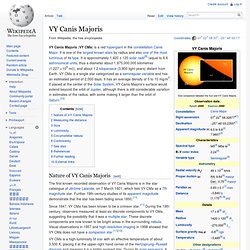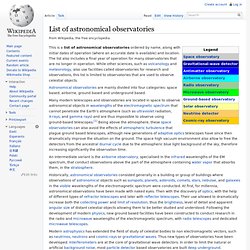

NASA. Water_World GJ1214b Super_Fluid Water & Hot_Ice #Psi. Space CleanerZ. EARTH'Z Cold Plasma HALO. TelescopeZ. DepthZ Of The GOV Aqua_Base. Aviatr Saturn. Milkyway. HMO Telescope. Cosmic RayZ. VY Canis Majoris. VY Canis Majoris (VY CMa) is a red hypergiant in the constellation Canis Major.

It is one of the largest known stars by radius and also one of the most luminous of its type. It is approximately 1,420 ± 120 solar radii[8] (equal to 6.6 astronomical units, thus a diameter about 1,975,000,000 kilometres (1.227×109 mi)), and about 1.2 kiloparsecs (3,900 light-years) distant from Earth.
VY CMa is a single star categorized as a semiregular variable and has an estimated period of 2,000 days. It has an average density of 5 to 10 mg/m3. If placed at the center of the Solar System, VY Canis Majoris's surface would extend beyond the orbit of Jupiter, although there is still considerable variation in estimates of the radius, with some making it larger than the orbit of Saturn.[10]
Comet Harpoon. Phobos Grunt. Saturday's Lunar Eclipse Will Include 'Impossible' Sight. Black Holes. Angel_WorldZ. #UFO'Z. MARS. Most liveable alien worlds ranked. 23 November 2011Last updated at 18:59 Saturn's moon Titan bears many similarities to the early Earth Scientists have outlined which moons and planets are most likely to harbour extra-terrestrial life.

Among the most habitable alien worlds were Saturn's moon Titan and the exoplanet Gliese 581g - thought to reside some 20.5 light-years away in the constellation Libra. The international team devised two rating systems to assess the probability of hosting alien life. They have published their results in the journal Astrobiology. In their paper, the authors propose two different indices: an Earth Similarity Index (ESI) and a Planetary Habitability Index (PHI). Continue reading the main story Earth - 1.00 Gliese 581g - 0.89 Gliese 581d - 0.74 Gliese 581c - 0.70 Mars - 0.70 Mercury - 0.60 HD 69830 d - 0.60 55 Cnc c - 0.56 Moon - 0.56 Gliese 581e - 0.53 The maximum value for the Earth Similarity Index was 1.00 - for Earth, unsurprisingly.
Continue reading the main story. A high-res Earth from 512 miles (photos) The Visible Infrared Imager Radiometer Suite, or VIIRS, onboard NASA's newest Earth-observing satellite acquired its first image this week, a stunning view of Eastern North America from Canada's Hudson Bay past Florida to the northern coast of Venezuela.

The low-Earth orbit satellite known as NPP carries five instruments as it travels at 16,640mph at an altitude of 512 miles. It was launched October 29 from Vandenberg Air Force base in California on a mission to observe Earth's environment and climate. NASA says the tools aboard the NPP will be used in monitoring that planet's environment, exposing long-term patterns helpful in assessing the impact of climate change as well as providing data that will be used by meteorologists for weather forecasting. VIIRS will collect radiometric imagery in visible and infrared wavelengths of the Earth's land, atmosphere, and oceans. These zoomed images are portions of the larger image which was taken on Monday. Time Lapse View from Space. Strange Hyperactive Galaxies Shine in Hubble Telescope Photo. Astronomers have discovered a strange population of tiny, distant galaxies forming stars at a surprisingly rapid clip.

The researchers used the Hubble Space Telescope to spot the 69 hyperactive dwarf galaxies, which are about 9 billion light-years away from Earth. They're churning out stars so fast that their stellar population would double in just 10 million years. By contrast, it took the Milky Way 1,000 times longer to double its number of stars, researchers said. The new results are unexpected, since they're somewhat at odds with other recent studies of ancient dwarf galaxies. "Those studies suggest that star formation was a relatively slow process, stretching out over billions of years," study co-author Harry Ferguson, of the Space Telescope Science Institute (STScI), said in a statement.
Tiny, active galaxies The newly discovered dwarf galaxies are about 100 times smaller than the Milky Way, researchers said. The study will appear in a forthcoming issue of the Astrophysical Journal. X Launches Falcon 9 Rocket & Dragon Spacecraft into Space.
List of astronomical observatories - Wiki. This is a list of astronomical observatories ordered by name, along with initial dates of operation (where an accurate date is available) and location.

The list also includes a final year of operation for many observatories that are no longer in operation. While other sciences, such as volcanology and meteorology, also use facilities called observatories for research and observations, this list is limited to observatories that are used to observe celestial objects. Astronomical observatories are mainly divided into four categories: space based, airborne, ground based and underground based. An intermediate variant is the airborne observatory, specialised in the infrared wavelengths of the EM spectrum, that conduct observations above the part of the atmosphere containing water vapor that absorbs them, in the stratosphere. Moon. Sky. Tech: NASA's Puffin: Your Personal Aircraft? : Video. Spaceflight Now 2.